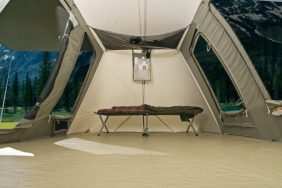 Outdoor gear like backpacks and tents are made with durable quality materials and expert craftsmanship. However, even with the technology and rigorous testing that go into designing and manufacturing the gear that keeps us safe, there are still improvements that we can make to boost their effectiveness. Today we’ll take a look at how you can seal your tent’s seams to make it more water resistant.
Outdoor gear like backpacks and tents are made with durable quality materials and expert craftsmanship. However, even with the technology and rigorous testing that go into designing and manufacturing the gear that keeps us safe, there are still improvements that we can make to boost their effectiveness. Today we’ll take a look at how you can seal your tent’s seams to make it more water resistant.
These days, tents and other gear tend to be made from waterproof materials, in order to withstand the elements. Still, waterproof materials that are stitched together in a tent need to be sealed if they’re not protected by the tent’s fly. Waterproof material sewn to a breathable or permeable fabric doesn’t need to be sealed, though, since water will go through the permeable fabric anyway, making sealing the seam pointless.
Some tents come with their seams factory sealed with clear seam tape on the coated side of the fabric, so you don’t need to worry about them. You can seal the other side of the seam if you wish, but it’s not necessary. Steer clear of sealer tape if you do decide to seal them yourself, as it doesn’t stick very well. Instead, two light coats of a water-based sealer on both sides of the seam is a better way to go.
There are several seams that you’d do well to seal if they’re not already taped. All main fly seams, for instance, will need to be sealed. On the body of the tent any corner seams, reinforcements or stake loops need to be sealed. Side wall seams where the floor and wall meet need to be sealed, too, unless they’re covered by the fly. Any outer seams around the tent’s windows and doors need to be sealed on the outside. If there’s webbing attached to the corners, it should be sealed from top and bottom unless it’s already factory taped. If your tent has a sewn-in floor with an outside perimeter floor seam, it’ll need to be sealed on the outside top and bottom all the way around the tent. Don’t seal this seam inside the tent because the seams are not accessible; you’ll end up gluing the floor and wall together, which will damage the floor and wall.
Finally, always make sure to seal any external guy points on the tent, or any other stress point on the outside of the fly by overlapping the sewn area on either side of the stitching. Also, seal the stitching of any Velcro loops on the fly. Be sure to keep from sealing a seam directly adjacent to a zipper because it will render the zipper unusable.
If you decide to add further sealant to the seams on your tent, the most important thing is to follow the directions on whatever brand of seam sealer that you use. Each tent is different, so you won’t need to seal the same seams on every tent you own. Reinforcing the seams on your tent will do wonders for its water-resistance, which you’ll appreciate during rainy days on the trail for years.








